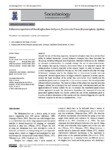Please use this identifier to cite or link to this item:
http://www.alice.cnptia.embrapa.br/alice/handle/doc/1005968| Title: | Defensive repertoire of the stingless bee Melipona flavolineata Friese (Hymenoptera: Apidae). |
| Authors: | NUNES, T. M.  ZUBEN, L. G. von   COSTA, L.   VENTURIERI, G. C.   |
| Affiliation: | Túlio Marcos Nunes, USP; Lucas Garcia von Zuben, USP; LUCIANO COSTA, CPATU; GIORGIO CRISTINO VENTURIERI, CPATU. |
| Date Issued: | 2014 |
| Citation: | Sociobiology, v. 61, n. 4, p. 541-546, Dec. 2014. |
| Description: | Despite the fact that Meliponini bee lost their sting apparatus (stingless bees), they did not lose their ability to defend themselves. A variety of defensive strategies is described for the group, such as bitting and resin deposition. Defensive behaviours are usually mediated by chemical communication such as alarm pheromones. This study describe the defensive strategies of the stingless bee Melipona flavolineata Friese 1900 towards known pheromone sources, the head secretions of the robber bee Lestrimelitta limao and the mandibular gland extract of conspecifics M. flavolineata workers. The pheromones provoked different defensive reactions. The head secretions of the robber bee repelled returning foragers, elicited the enclosing of the nest entrance tube with batumen balls and agglomeration of workers outside of the box. In contrast, the mandibular gland extract elicited aggression towards the pheromone site, transport of resin and generalised agitated flights. The results confirm the mandibular gland as a source of alarm pheromone for this specie and also the chemical triggering of defensive response for the known cleptoparasite L. limao. |
| Thesagro: | Abelha |
| Keywords: | Defesa |
| DOI: | 10.13102/sociobiology.v61i4.541-546 |
| Type of Material: | Artigo de periódico |
| Access: | openAccess |
| Appears in Collections: | Artigo em periódico indexado (CPATU)  |
Files in This Item:
| File | Description | Size | Format | |
|---|---|---|---|---|
| 64237811PB.pdf | 733,24 kB | Adobe PDF |  View/Open |









